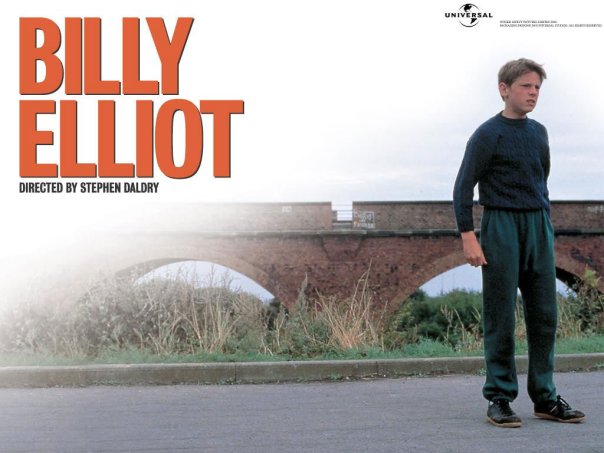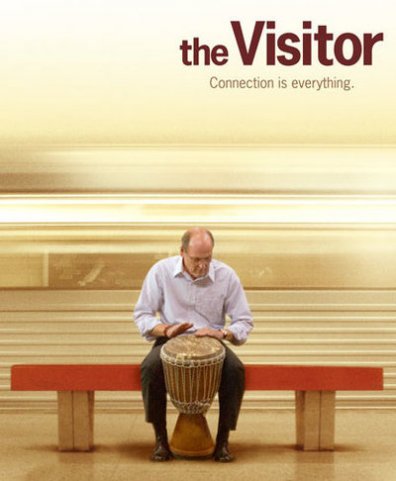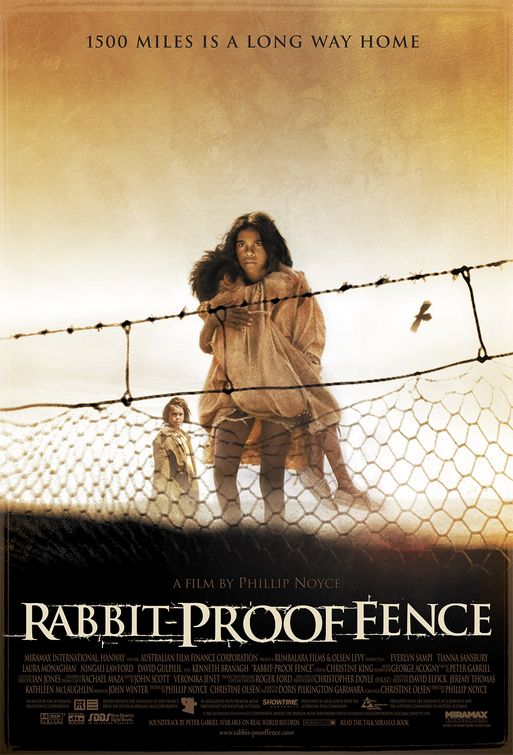Billy Elliot
 Billy Elliot is a story of tenacity and perseverance. This young boy from County Durham, England, was torn between his desire to make his pa proud and his interest in dance. Specifically ballet. This is something that’s not only unconventional in Billy’s town, it’s bizarre. The son of a former boxer taking ballet lessons??? But that’s exactly what happened.
Billy Elliot is a story of tenacity and perseverance. This young boy from County Durham, England, was torn between his desire to make his pa proud and his interest in dance. Specifically ballet. This is something that’s not only unconventional in Billy’s town, it’s bizarre. The son of a former boxer taking ballet lessons??? But that’s exactly what happened.
This story was both heartwarming and comedic at once. As the viewer, you felt profound sympathy for the young boy who grew up missing his mother to the core and wanted nothing more than to make his father proud. Then you’d get amused by the rude manner with which Billy treated folks around him. Yet, while doing so, there was a ballet teacher who saw that drive within him that she felt could take him past his future coal mining life. I believe what she saw was a deep love for music and dance. He was inspired to dance and enjoy life just as his mother would have been. Billy used his tough upbringing to achieve what he wanted even when it meant looking like a sissy in front of his family and their friends. He didn’t care that boys weren’t supposed to dance ballet because he wasn’t looking to fit any norm. He wanted to do what moved him. What inspired him. And isn’t that what art’s all about?
Like the other movies we’ve seen thus far in the semester, this one highlights the power of art through transformation. Billy Elliot was transformed from an awkward boy to a graceful swan. Billy’s father, whose rugged and callous exterior seemed impenetrable, went from being apathetic to loving because he was able to see that what he thought was best for Billy (boxing) wasn’t that which Billy loved. Even Billy’s older brother Tony came around. Art, in the form of dance, changed Billy’s life because he was willing to see past the acceptable norms for a boy and chase the dream he wanted.
Waste Land
http://www.wastelandmovie.com/index.html
Waste Land, a documentary featuring world renown artist Vik Muniz, is an eye-opening, jaw-dropping, and perhaps one of the most emotionally provocative films I have ever seen. It is so powerful that I believe it may change my outlook on life. I feel as though this is a must see for any citizen or resident of so called first world countries. It induces a sense of guilt that I hadn’t felt from a film in a very very long time.
As an artist, Vik Muniz had already established himself internationally. He’d made enough money to live in a city such as New York even though he’s of Brazilian nationality. Yet his next project was one that he wanted to use as a method to change people’s lives in his birth city, Rio de Janeiro. He envisioned working with a most unusual medium; recycled materials from a landfill. And not just any landfill. Jardim Gramacho; site of the largest collection of trash in the world which sits just outside Brazil’s most well known city. Vik flies to Rio to study the site and meet the people who would help him create marvelous works of art. In his process of working with some of the catadores (pickers), Vik becomes invested in these people’s lives and their own struggles.
Muniz’s goal is to transform people. He believes that art gives him the opportunity to offer a possibility of transformation to the catadores.He tries to transmit to his new friends that “transformation is the stuff of art” and the process of making a material into an idea can open new meanings to life. His belief that art can change people is the reason he tries mixing art with his social project. He wishes to pull people out what he thought might be miserable lives and give them a glimpse of another world that may be better. This is why he goes to the people he identifies as those “at the end of the line.” He allows for them to show him what they want to show and in the process give them ownership over the art that’s being created.
This is what made this film so beautiful. The artist and director show the viewer how art can transform a group of people who’ve been dealt some tough cards in life. As hard as I tried, I couldn’t even begin to imagine what it must be like to live the life of a catador. We’re so accustomed as Americans to buying this and replacing that and dumping all that we dont stop to think about where these things end up and who deals with them. As a nation that’s as spoiled as can possibly be, we purposely forget that there are those who dig through our trash to find their means through life. And this film exposed us. Or at least it exposed that guilt within myself. I think of trash and see absolutely no use for any of it. As i’m sure is the case with most, I just want it out of my house before it smells. Yet these people not only live in places where trash is in there immediate surroundings, they found a way to make art out of “nothing.” Vik showed these people how to look past what they grew accustomed to see everyday as only recyclables and see art. He showed them a route out of their tough lives and left it up to them to take that route. And… he showed me that art can be made of ANYTHING. More importantly, he made me realize how lucky I am to live where I live and how I live.
MandoBasso

The concert offered by MandoBasso musicians Gunnar Biggs (Bass) and Bill Bradbury (Mandolin) was entertainment fused with musical education. Having never before heard the tune of a mandolin, I was immediately captured by the high-pitched tones emanating from the instrument. It was something almost enchanting and kept me drawn even when I thought the song might begin to lull. I have to admit that there were times when I felt that the rhythm might have been helped by a change here or there, but then again, I’m no music expert and wouldn’t know what might have helped. I felt as though at times the bass fought against instead of working with the mandolin.
However, I loved the fact that both musicians would slow down between songs to explain to the audience what they were playing next and why they were playing what they played. I felt as though I learned soooo much about music in 2 hours that I hadn’t learned in 27 years! I came out of this music session feeling like a folk music fan. And that’s something I never thought I’d hear myself say.
Rabbit-Proof Fence
Rabbit-Proof Fence is a heart wrenching movie based on the real life story of three young girls living in the Australian outback in 1931. These girls formed part of what was known as the “Stolen Generation,” the group of aborigines forcibly removed from their homes/families during childhood and compelled to learn the more “intelligent” or civilized white ways. Its a story that will induce many feelings such as anger and disbelief.
This movie presents the story of Molly, her younger sister Daisy, and younger cousin Gracie. These three girls are kidnapped by the government and removed from their home in Jigalong to a settlement, somewhat like concentration camps, 1500 miles to the south known as Moore River Native Settlement. This is a camp that was thought up by the government to solve the “problem” of half-castes by breeding them out. Half-castes were aboriginal children who had a white parent and aboriginal parent. The man in charge of this task is Mr. A.O. Neville (known by the aborigines as Mr. Devil). As Chief Protector of Aborigines, Mr. Neville believes it his duty to find a solution to the problem of half-castes as it will not go away on its own accord. The movie portrays him as a man who strongly feels that if not taken care of, the problem will fester for years and that the bush people must be protected against themselves. He tries to convince other Australian female citizens that “inspite of himself, the native MUST be helped.” And what’s his plan to carry out his mission? To continuously breed whites with natives until “the continuing infiltration of white blood finally stamps out any trace of black color.”
Now, I’m not sure how familiar you are with world history, but there was a short man about 70 years ago with the same so-called duty. He went by the name of Hitler. I know, his methods may have been a wee bit different, however, the end result that was sought after seems the same. Ethnic cleansing. Many might hesitate to use the word genocide being that the film doesn’t show a whole lot of violence. But does genocide need to be accompanied by violence to be genocide? The methods employed by white australians of the time were not as extreme as those used by Nazis or Bosnian soldiers, but they had the same intent: To eradicate a people. In the Moore River Settlement, children were being re-educated to make them forget their culture. On top of working in a sweatshop, they were forced to only speak english and are made to believe that a child with fair skin is more intelligent than one with dark. And while at these camps, the women were trained to work as domestic servants or farm laborers. They were being forced to forget their own culture and become accustomed to the white one.
To sum it all up, I really liked this film. I tend to love historical pieces and this one caught me from very early on. I found myself constantly rooting for our three heroines the entire 1500 mile journey to Jigalong. I was saddened by the capture of young Gracie and joyful at the reunion between Molly and her younger sister Daisy with their mother and grandmother. But more than anything, I found myself angry. Angry that humans could be so stupid. Angry that people get mistreated or walked all over “for their own good.” And angry at the thought that this is still something that occurs this day in age.
Frida
Frida was an extremely inspirational movie that told the story of a woman who struggled all her life and gave us a pictorial of it to follow along. She was an exceptionally talented woman who could portray her life with painting in ways that would be difficult with words. She had the ability to create art out of the worst circumstances.
After suffering a terrible accident on a bus as a young girl, Frida spent the following two years of her life bedridden. During this time she began to paint herself thanks to a mirror her father placed above her bed. After completing more and more paintings, she decides to have them critiqued by “el panzon” Diego Rivera, who discovers in her a talent unlike any other he’d known, and with it, the beginning of their tumultuous relationship. Frida is drawn to Diego though she knows he’s a famed womanizer and decides to take a chance with him. She can forgive his womanizing as long as he remains “loyal” to her. This, of course, does not happen since he’s psychologically incapable of fidelity. She decides to look past his little betrayals until he sleeps with his sister. Here is where their relationship becomes rockiest. Frida later decides to engage in an affair with communist Leon Trotsky and eventually leaves Mexico for Paris.
While in Paris, Frida gains recognition somewhat but is not truly content because she discovers she misses Diego too much. She returns only to find that he’s leaving for California and wants a divorce. Once he leaves, her physical ailments continue and she is left in a wheelchair with only her art to console her. Later, Diego returns to her side and they remarried. The movie also shows the defiant Frida, not willing to miss her own art exhibition in her beloved country, making a grand entrance into the art gallery still in her bed being carried by various men. This scene was captivating because in a way, it showed the person Frida was throughout her entire life; a fighter. And art was her inspiration. Her motivation.
She didn’t create her art to make money off it. She made art because she was passionate. She told her life in a very explicit way and barred no details. Director Julie Taymor points out that she “had the ability to be both macabre, grotesque and at the same time exquisitely beautiful.”
My favorite line in this movie is given by Alfred Molina (playing Diego Rivera) when describing Frida to attendees of her exhibit–
Her work is acid and tender,
Hard as steel and fine as a butterfly wing.
Lovable as a smile, cruel as the bitterness of life.
The Visitor

The Visitor is one of those “gonna make you feel good no matter what movies” that all should watch. At first you’re put off by the stiff, uptight, bland character of Walter Vale. He’s a professor at some university in Connecticut who seems to have little care or love for life and those who live it around him. He lacks motivation and seems to be “zombie-ing” his way through life. Then he gets forced into a conference he wants no part of. Fortunately for him, and the story, he goes and in doing so will have his whole world turned upside down, for the better.
Walter arrives to his long abandoned NY city apartment to find that he has two unexpected and uninvited guests living there. After scaring the hell out of the couple, they decide to leave before Walter can have a chance to call the police. And when they leave, they flip a switch within him that shows a human side for the first time in the movie; he feels guilt and worry. Lucky for him, Tarek and Zainab (the uninvited couple) decide to stick around and live with their new visitor for a few days while they look for another place to stay. The few days turn out to be a little more long term as Walter and Tarek form a friendship around Tarek’s passion, music through the Djembe. Tarek not only plays the instrument, but also teaches Walter how to do so. The Visitor becomes enthralled by this instrument and begins to feel the beats everywhere, whether at home in his underwear or in a meeting room. Walter discovers within him a musician awaiting his release.
Unfortunately, this occurs unilaterally with the arrest of Tarek, of course for a petty crime he did not commit. The dilemma is that both Tarek and Zainab are illegal immigrants in a country that has changed its approach to such peoples in the wake of terrorist attacks on 9-11. So Tarek is incarcerated in a detention center and it is Walter, the same man who was unconcerned with other human emotions, who visits his good friend Tarek while imprisoned. He finds himself caring not only for Tarek and his mother and girlfriend, but he’s genuinely bothered by the unfairness with which immigrants are treated in our country.
My belief is that director Thomas McCarthy wanted to show us viewers that music has the ability to transform a person. It is capable of turning a callous man into a caring one. It’s capable of developing a musician out of a washed-up professor of economics. It’s capable of giving meaning to life. Walter, The Visitor, found a passion.
Once: Academy Awards Acceptance
As entertaining as the movie was, the Oscar acceptance by Glen Hansard and Marketa Irglova provided viewers with an inspirational moment in which one could catch a glimpse into the motivation driving a true artist.
Art is not always created with the intent to cash in on one’s own talents. Nor is money needed to create art that is capable of stirring the emotions of many people, no matter the cultural barriers. Glen Hansard urges all viewers to “make art” and, in doing so, it gives us the sense that he begs for art to be made in its purest form; to share one’s creation with the world. It gave me the sense that he believes art is not intended to be sold to the highest bidder but to be created for the purpose of being shared with the world. After being cut-off, Marketa Irglova uses her opportunity to speak to the world to tell us all that “no matter how far out [our] dreams our, it’s possible” to achieve them. She finishes her speech by stating that “hope connects us all.” I’m not sure if by saying hope she meant to say art but I do believe that art has the ability to connect people no matter what cultural differences may exist. Art talks to people in ways that can move or inspire one to work towards something that may be bigger or better. I feel as though this was what Marketa and Glen wanted to tell us in their acceptance speeches.



